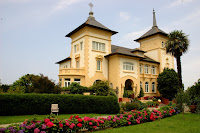A few years ago it all got a bit more complicated because there were rule changes about the taxation of overseas pension income. Well that and that I'd been evading tax just a little. HM Revenue and Customs dobbed me in to the Spaniards and told them about the 300€ or so I get each year from a tiny AVC pension fund. Pedro, a nice accountant in Molina de Segura sorted it all out for me and I stuck with him the next tax year too. Last year though I went back to doing it myself and ended up with a tax bill of about 1,200€ which was a bit of a shock. That amount represents a bit below four months pay from my very part time. It didn't seem fair or right but, after lots of Googling and questions on expat forums, the evidence suggested it was as it should be. So I gritted my teeth and paid up.
This year I added my pension to the draft tax return form online again and it looked as though I owed around 400€. I decided to ask an accountant, just to be sure. My appointment was this morning. All the sums done the accountant told me the tax people owed me about 50€. This is a good result. It turns out that accountants can do something on the tax returns that private individuals can't so, by not going to an accountant last year, I had doomed myself to overpaying my taxes. I'm taking a positive view of this and being thankful. I am not going to cry over last years spilled milk. There's the sweet.
In February of 2017 we got a huge "rates" demand. Well huge by our standards. Another five months of part time work's worth. With a bit of checking it turned out that there was an error. We are paying the rates for most of our neighbours house!
I put in an appeal with the Land Registry, the Catastro, and waited for something to happen. After about five months I sent an email asking, very politely, if they had any news. They told me they had, by law, up to six months to reply. I asked again after nine months and they told me that the matter was "under consideration". It's now around 15 months and their recent reply was also to wait. Taking on the Land Registry in hand to hand combat is not something I relish. So I booked in for an appointment with the local Consumer Protection Office to see if they could do anything on our behalf. My appointment was this afternoon. Their advice was to go to the Land Registry Office in Alicante and make my case face to face. Not exactly the sort of help I was looking for. Perhaps the most depressing thing was that the chap who suggested this also gave me the address for the local ombudsman rather suggesting that he's not hopeful about the outcome. And that's the sour.














